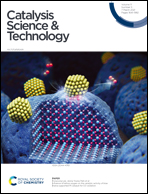Mechanistic insight into the influence of O2 on N2O formation in the selective catalytic reduction of NO with NH3 over Pd/CeO2 catalyst†
Abstract
Noble metal nanoparticles supported on metal oxides have been extensively investigated as potential selective catalytic reduction (SCR) catalysts to control NOX emissions, but suffer from the formation of N2O. Herein, the N2O formation mechanism during the NH3-SCR process over the Pd/CeO2 catalyst was investigated by both experimental methods and density functional theory calculations. Our results revealed that O2 greatly affected the pathway for NO reduction, which resulted in a temperature-dependent SCR performance and N2O formation. At a temperature below 175 °C, fast-SCR was the main reaction route for NO removal, which was attributed to the spontaneous oxidation of NO to NO2. In the temperature range of 175–250 °C, the activation of NH3 facilitated the reduction of NO through standard-SCR, which promoted the removal of NO but also induced the formation of N2O. At a temperature above 250 °C, NH3 was severely deep oxidized, which induced the formation of excess N2O in the presence of even a low amount of O2 of 1 vol%.



 Please wait while we load your content...
Please wait while we load your content...